Abstract
The role of genetic factors associated with the immunoglobulin heavy chain locus (Igh) in the development of benign monoclonal gammapathy (BMG), a benign B-cell proliferative disorder, was investigated in six Igh congenic mouse strains during ageing. The strains used had a C57BL or BALB background: C57BL/6, BALB.Igb and CB-20 carrying the C57BL Igh (Ighb allotype), BALB/c and C57BL/6.Iga carrying the BALB/c Igh (Igha allotype) and BAB-14, that is of BALB/c origin with the exception of the constant part of the Igh, which is of C57BL origin. The frequency of homogeneous immunoglobulins (H-Ig), both single and multiple, was the highest in C57BL/6 mice, followed by C57BL/6.Iga. The frequencies of H-Ig in BALB.Igb and CB-20 mice were higher than those of BALB/c and BAB-14, although somewhat lower than in C57BL/6.Iga mice. Multiple H-Ig were found especially in the sera of C57BL/6 mice. Categorization of the monoclonal gammapathies (MG) on the basis of their origin showed a single transient monoclonal B-cell proliferation in 0-8% of the mice of all strains. Persistent, non-progressive MG, presumably BMG, were detected in 64% of C57BL/6, 30% of C57BL/6.Iga, 22% of BALB.Igb, 17% of CB-20, 13% of BAB-14 and 6% of BALB/c mice. Multiple myeloma or Waldenström-like B-cell lymphoma were found to be responsible for 2-4% of the paraproteinemias in all strains. The remaining H-Ig, varying from 11% of the C57BL/6 to 70% of the BAB-14 mice, could not be evaluated in time. The most frequent isotypes of the BMG within C57BL/6 and C57BL/6.Iga were IgG2a and IgG2b, respectively; IgM was the most frequent isotype within the four BALB congenic strains. The immunoglobulin heavy chain allotypes under investigation appeared to be only partly related to the onset, occurrence, multiplicity and persistence of the BMG developing in these Igh congenic C57BL and BALB strains during ageing. The immunoglobulin heavy chain allotypes, however, were not related to the major isotype of the BMG. The results obtained in CB-20 and BALB.Igb on the one hand, and in BAB-14 on the other hand, may suggest a role for the variable part of the Igh in the development of BMG. Since no absolute influence could be ascribed to the Igh, we assume that primarily other genetic sequences regulating proliferative B-cell functions account for the pathogenesis of BMG.
Full text
PDF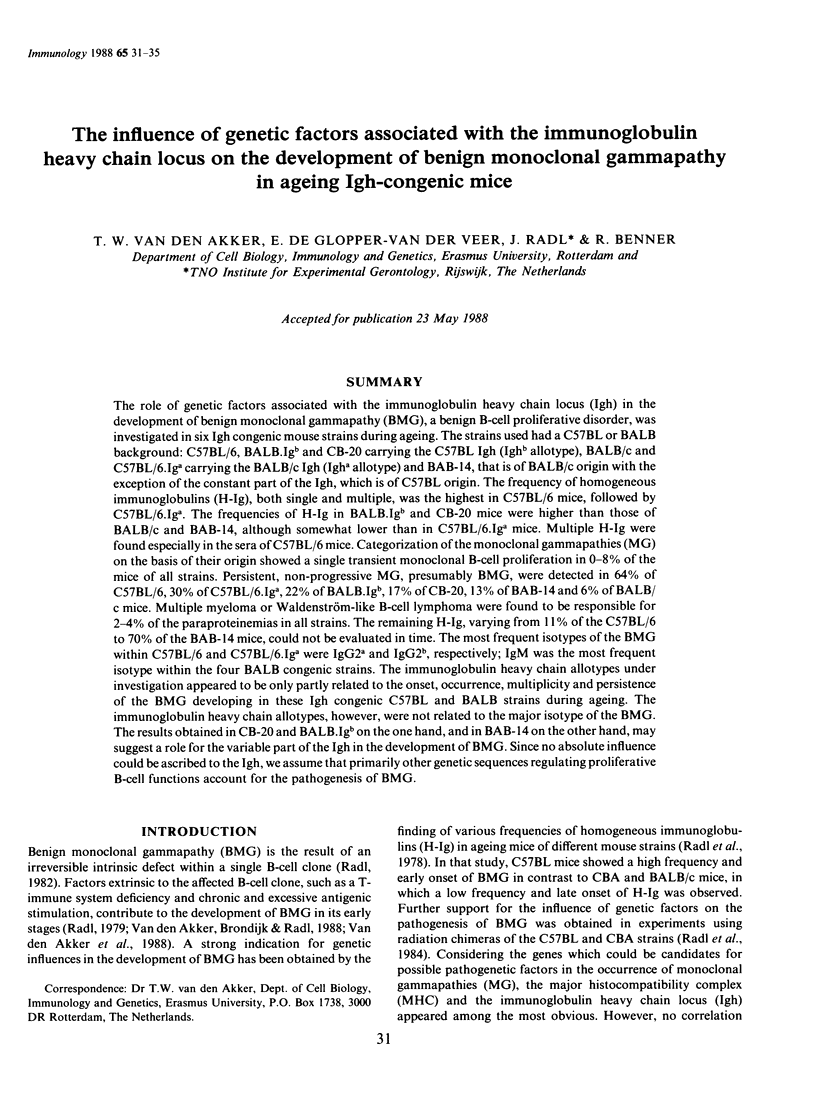
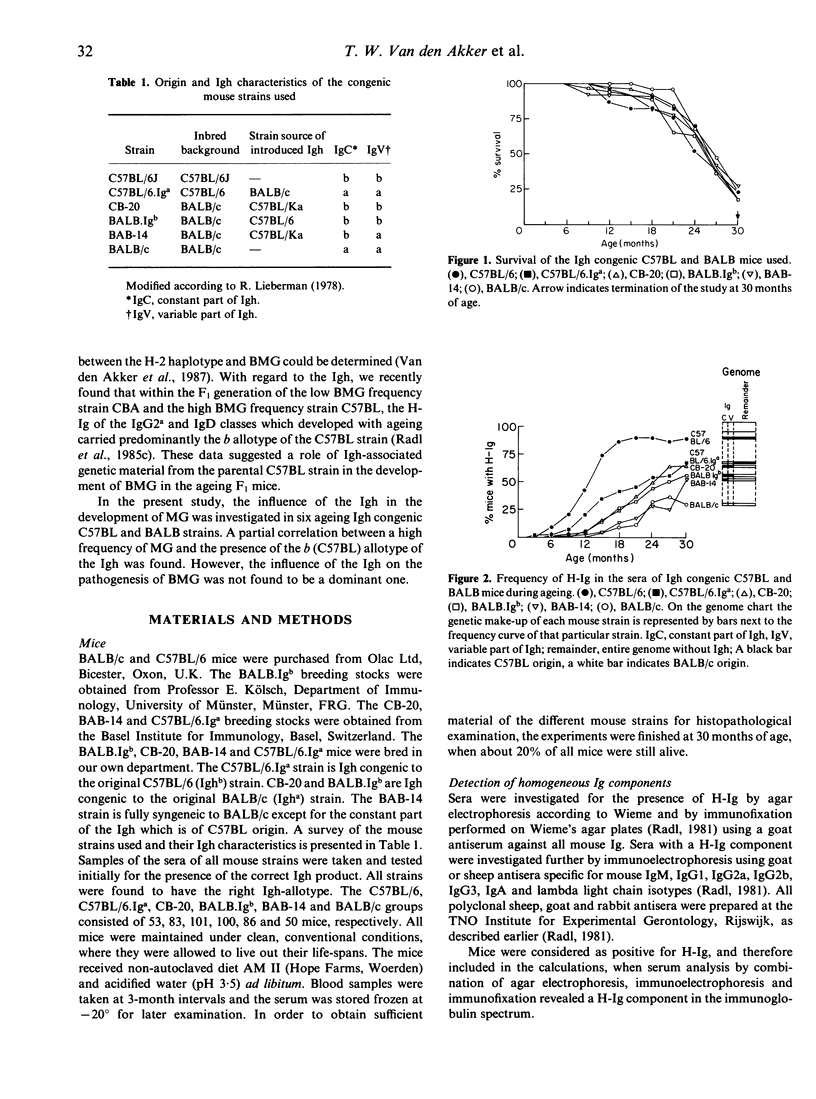
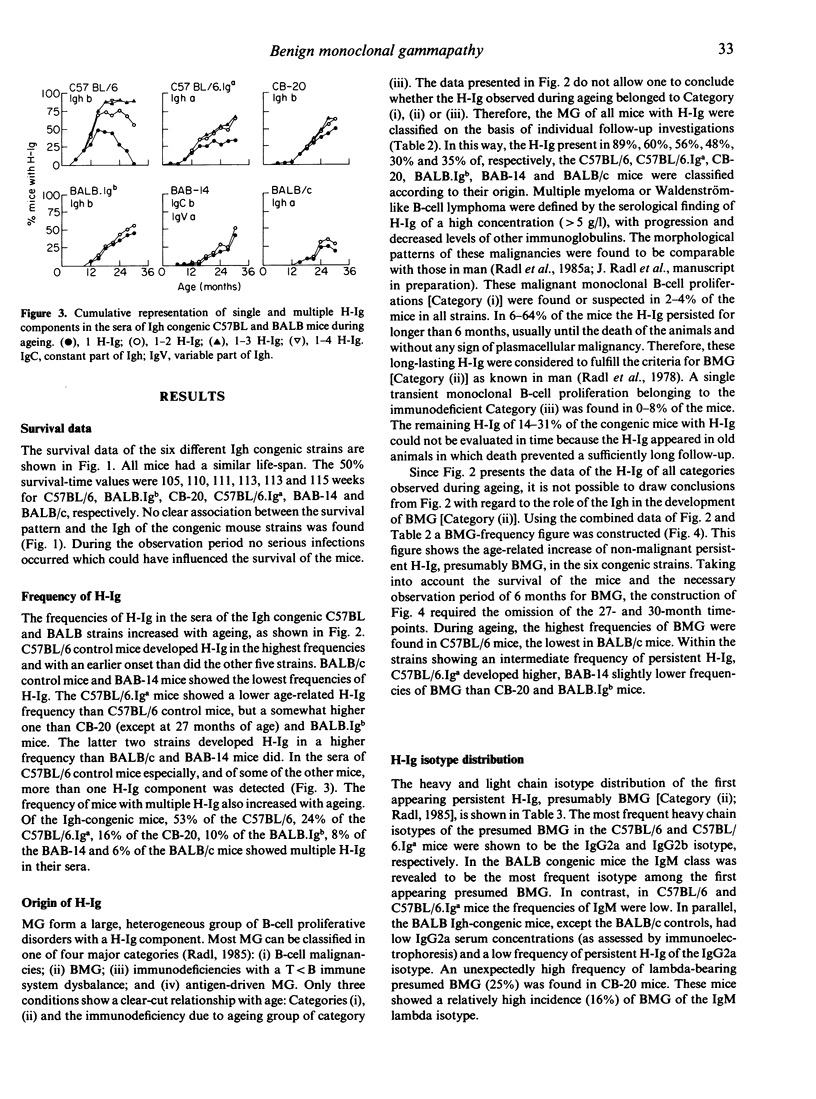
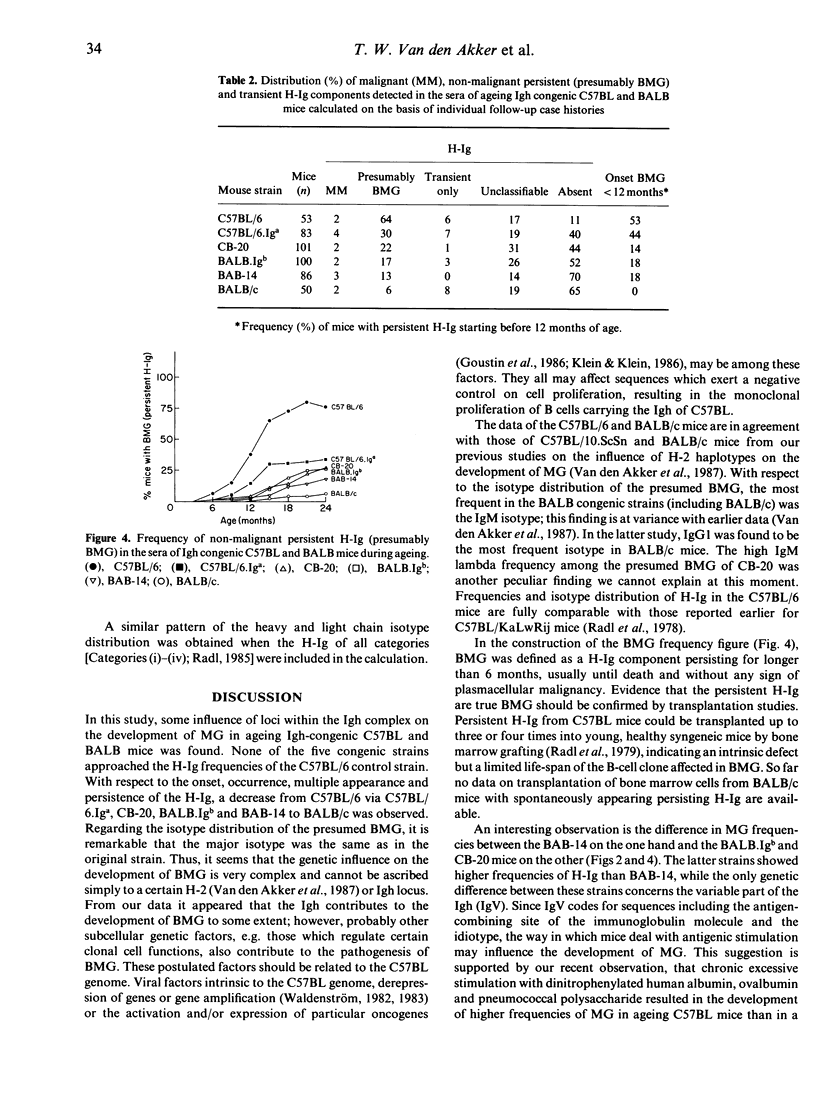
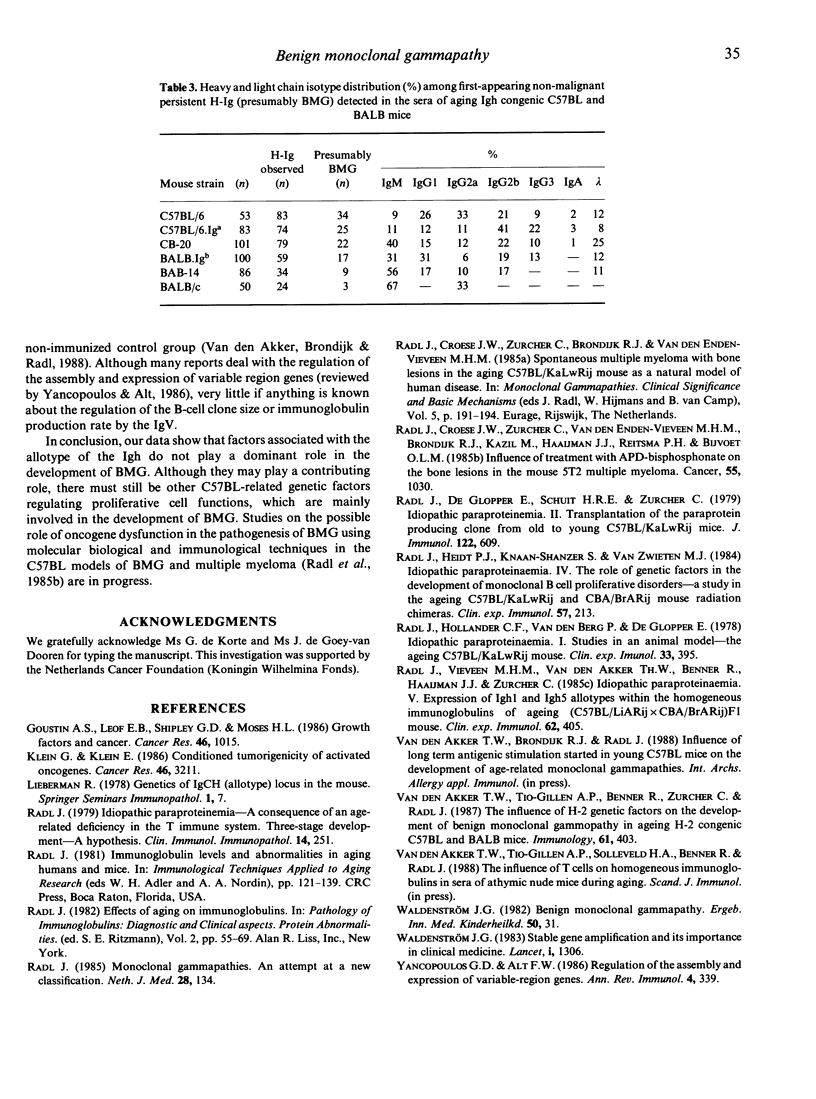
Selected References
These references are in PubMed. This may not be the complete list of references from this article.
- Goustin A. S., Leof E. B., Shipley G. D., Moses H. L. Growth factors and cancer. Cancer Res. 1986 Mar;46(3):1015–1029. [PubMed] [Google Scholar]
- Klein G., Klein E. Conditioned tumorigenicity of activated oncogenes. Cancer Res. 1986 Jul;46(7):3211–3224. [PubMed] [Google Scholar]
- Radl J., Croese J. W., Zurcher C., van den Enden-Vieveen M. H., Brondijk R. J., Kazil M., Haaijman J. J., Reitsma P. H., Bijvoet O. L. Influence of treatment with APD-bisphosphonate on the bone lesions in the mouse 5T2 multiple myeloma. Cancer. 1985 Mar 1;55(5):1030–1040. doi: 10.1002/1097-0142(19850301)55:5<1030::aid-cncr2820550518>3.0.co;2-y. [DOI] [PubMed] [Google Scholar]
- Radl J., De Glopper E. D., Schuit H. R., Zurcher C. Idiopathic paraproteinemia. II. Transplantation of the paraprotein-producing clone from old to young C57BL/KaLwRij mice. J Immunol. 1979 Feb;122(2):609–613. [PubMed] [Google Scholar]
- Radl J., Heidt P. J., Knaan-Shanzer S., van Zwieten M. J. Idiopathic paraproteinaemia. IV. The role of genetic factors in the development of monoclonal B cell proliferative disorders--a study in the ageing C57BL/KaLwRij and CBA/BrARij mouse radiation chimeras. Clin Exp Immunol. 1984 Oct;58(1):213–216. [PMC free article] [PubMed] [Google Scholar]
- Radl J., Hollander C. F., van den Berg P., de Glopper E. Idiopathic paraproteinaemia. I. Studies in an animal model--the ageing C57BL/KaLwRij mouse. Clin Exp Immunol. 1978 Sep;33(3):395–402. [PMC free article] [PubMed] [Google Scholar]
- Radl J. Idiopathic paraproteinemia--a consequence of an age-related deficiency in the T immune system. Three-stage development--a hypothesis. Clin Immunol Immunopathol. 1979 Oct;14(2):251–255. doi: 10.1016/0090-1229(79)90147-8. [DOI] [PubMed] [Google Scholar]
- Radl J. Monoclonal gammapathies. An attempt at a new classification. Neth J Med. 1985;28(3):134–137. [PubMed] [Google Scholar]
- Radl J., Vieveen M. H., van den Akker T. W., Benner R., Haaijman J. J., Zurcher C. Idiopathic paraproteinaemia V. Expression of Igh1 and Igh5 allotypes within the homogeneous immunoglobulins of ageing (C57BL/LiARij X CBA/BrARij)F1 mouse. Clin Exp Immunol. 1985 Nov;62(2):405–411. [PMC free article] [PubMed] [Google Scholar]
- Waldenström J. G. Stable gene amplification and its importance in clinical medicine. Lancet. 1983 Jun 11;1(8337):1306–1306. doi: 10.1016/s0140-6736(83)92416-9. [DOI] [PubMed] [Google Scholar]
- Waldenström J. G. The benign monoclonal gammapathies: a study of monoclonal antibodies. Ergeb Inn Med Kinderheilkd. 1982;50:31–77. doi: 10.1007/978-3-642-68546-0_2. [DOI] [PubMed] [Google Scholar]
- Yancopoulos G. D., Alt F. W. Regulation of the assembly and expression of variable-region genes. Annu Rev Immunol. 1986;4:339–368. doi: 10.1146/annurev.iy.04.040186.002011. [DOI] [PubMed] [Google Scholar]
- van den Akker T. W., Tio-Gillen A. P., Benner R., Zurcher C., Radl J. The influence of H-2 genetic factors on the development of benign monoclonal gammopathy in ageing H-2 congenic C57BL and BALB mice. Immunology. 1987 Aug;61(4):403–408. [PMC free article] [PubMed] [Google Scholar]


